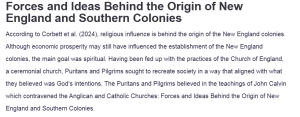Forces and Ideas Behind the Origin of New England and Southern Colonies
According to Corbett et al. (2024), religious influence is behind the origin of the New England colonies. Although economic prosperity may still have influenced the establishment of the New England colonies, the main goal was spiritual. Having been fed up with the practices of the Church of England, a ceremonial church, Puritans and Pilgrims sought to recreate society in a way that aligned with what they believed was God’s intentions. The Puritans and Pilgrims believed in the teachings of John Calvin which contravened the Anglican and Catholic Churches: Forces and Ideas Behind the Origin of New England and Southern Colonies.
Following the demise of Elizabeth, the agents of the Stuart Family that reigned afterward harassed the Pilgrims and Puritans. In particular, the Pilgrims were labeled separatists while Puritans were targeted for their attempts to purify the Church of England. By the 1600S, Puritans and Pilgrims concluded that England was not suitable for their religious and spiritual interests. These developments led to them moving to America which was regarded as spiritually pure.
On the other hand, Southern colonies were primarily established for economic reasons. The Southern colonies were characterized by a warm climate and fertile soil (Craven, 2015). The Settlers of the Southern colony who could not find economic prosperity in old England moved to America, hoping to realize feasible economic ventures. The England countryside was already full and any estates were mostly passed to the eldest son in the family, effectively limiting the prospects of other family members to prosper there.
To that end, America provided the settlers with opportunities they could not achieve in their native land. For instance, in Maryland, tobacco became the main cash crop, providing significant revenue to the local communities (Corbett et al., 2024). Notably, enslaved Africans provided labor in these farms once the relationship between settlers and American natives deteriorated.
References
Corbett, P. S., Janssen, V., Lund, J. M., Pfannestiel, T., Waskiewicz, S., & Vickery, P. (2024). US history. https://openstax.org/books/us-history/pages/3-3-english-settlements-in-america
Craven, W. F. (2015). The Southern Colonies in the Seventeenth Century, 1607–1689: A History of the South (Vol. 1). LSU Press.
ORDER A PLAGIARISM-FREE PAPER HERE
We’ll write everything from scratch
Question
Read/review the following resources for this activity:
Initial Post Instructions
In preparation for the initial post, consider two (2) of the following settlements:
- Southern colonies
- Chesapeake colonies
- Middle colonies
- New England colonies
Forces and Ideas Behind the Origin of New England and Southern Colonies
Then, in one (1) to two (2) paragraphs, address one (1) of the following options:
- Compare and contrast the settlement patterns.
- What forces and ideas shaped their origin?
- Examine the influence of religion on those settlements (e.g., Puritanism, Quakers, and the Anglican Church).


